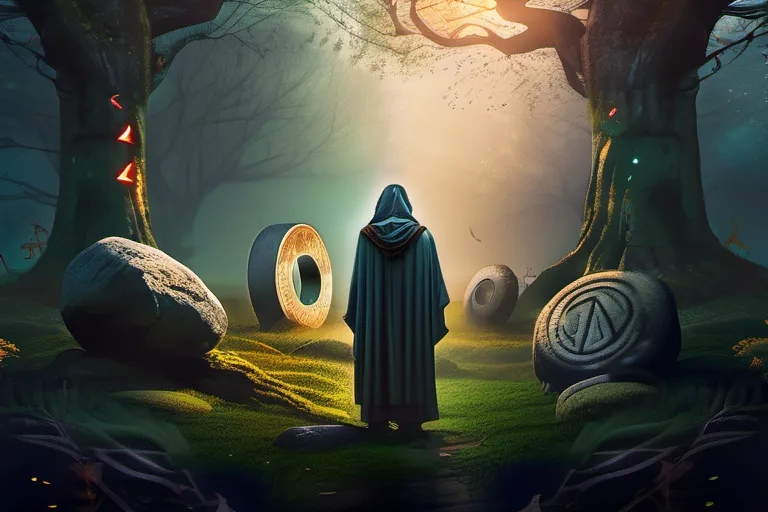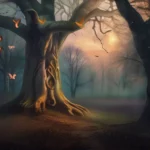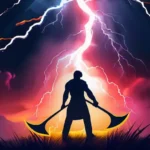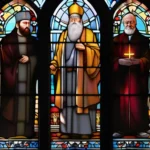Explore the history, beliefs, practices, and modern resurgence of this ancient pagan religion.
Druidism is an ancient pagan religion that has captivated scholars and enthusiasts alike for centuries. Originating in pre-Roman Gaul, Druidism was a complex system of beliefs centered around nature, the cycles of life, and the interconnectedness of all things.
The Origins of Druidism
Imagine peering into the hazy past, where the origins of Druidism first emerged in the misty forests and rolling hills of pre-Roman Gaul. These ancient shadows, once cloaked in mystery, now reveal a rich tapestry of beliefs and practices that have captured the imagination for centuries.
Druidism, an ancient Celtic religion, has its roots deeply embedded in the soil of Europe. It is often described as a form of nature worship, where every tree, river, and mountain held sacred. The Druids themselves were considered the intellectual elite, acting as keepers of knowledge, healers, and spiritual leaders.
But how did these ancient practitioners gain such reverence? Perhaps it was their unique approach to understanding the world around them. They believed in a complex system of deities, nature spirits, and the interconnectedness of all life. These beliefs were not just personal; they were woven into the fabric of society.
The practices of Druidism were both spiritual and practical. Rituals often involved sacred groves, where rituals for fertility and protection took place. Astrology played a significant role in their lives, guiding them through the seasons and marking important events. The knowledge passed down through generations was held in secret, preserved only among those deemed worthy.
The Druids of old were not merely passive observers; they were active participants in shaping their world. Their wisdom influenced everything from agriculture to medicine, leaving a profound legacy that continues to intrigue historians and enthusiasts alike.
As we delve deeper into the origins of Druidism, one question lingers: Can modern society learn something valuable from these ancient practices? The echoes of Druidic beliefs still resonate in our own quest for balance with nature and understanding of the spiritual world. Perhaps, in exploring their past, we can uncover timeless truths that guide us into a more harmonious future.
Druids in Roman Times
As the Roman legions marched through Gaul, they encountered a society steeped in mystery and tradition—society ruled by wisdom keepers. The Druids were these revered figures, custodians of an ancient wisdom that had been passed down for centuries. But how did this powerful class interact with Rome? And what impact did the Roman conquest have on the very essence of Druidism?
Roman accounts paint a picture of Druids as both respected and feared. They were not mere religious figures but also philosophers, judges, and healers—roles that often brought them into direct conflict with Roman authorities. The Romans saw them as a threat to their authority because Druidic practices sometimes clashed with the laws imposed by Rome. Imagine Druids standing resolutely against Roman domination, much like a tree rooted deeply in the earth resisting a strong wind.
The confrontation between Druids and Romans was not just about religion; it was also about power. The Druids had their own form of education, where initiates were subjected to strict physical and mental discipline. This made them formidable opponents when they stood up against Roman forces, as the De Origine Gentis Gaetuliae attests to in its vivid descriptions of their defiance.
Yet, as Rome extended its rule over Gaul, many Druids found themselves caught between a rock and a hard place. They faced the choice of either integrating with Roman culture or facing suppression. Some may have embraced the new order, seeing it as a means to maintain their practices under different circumstances. Others likely saw this as an inevitable end to their way of life.
The impact of Roman conquest on Druidism was profound. It wasn’t just about losing a land; it was about losing the very identity and tradition that defined them. The Decline of Druidism, following the Roman occupation, would see many practices suppressed or transformed, leaving only fragments of what once was.
In exploring the role of Druids during this tumultuous period, we not only uncover a chapter in ancient history but also gain insight into how cultures clash and adapt. The story of Druidism under Roman rule is one of resilience and transformation—a tale that continues to fascinate historians and spiritual seekers alike.
The Decline of Druidism
As we delve into the decline of Druidism, it’s like tracing the path of a once-thriving tree that slowly withers under the weight of time and external pressures. The fall of Druidism following the Roman conquest was not just a simple fade but a complex interplay of cultural clash, religious suppression, and societal shifts. Imagine Druidism as a mighty oak tree, its roots deep in ancient Celtic soil, branches stretching across Europe. But when the Romans arrived, they brought with them not just military might but also their own set of beliefs and practices.
The Roman conquests of Gaul and Britain marked a turning point for Druidism. The Romans saw the Druids as both a source of pagan mystery and a threat to Roman control. They viewed the Druids’ ritualistic sacrifices, particularly human ones, with horror and sought to eradicate them. The famous account by Cassius Dio describes the brutal suppression of Druid practices in Britain, where entire communities were targeted for their beliefs.
But the story doesn’t end there. As Roman influence spread, so did Christianity. The Christianization of Europe brought with it a new set of religious doctrines that often clashed with Druidic traditions. Think of it as two vastly different streams meeting: one rooted in ancient nature worship and mystical rites, the other grounded in monotheism and strict moral codes. The struggle between these belief systems was intense, leading to the suppression or outright ban of Druidic practices.
The efforts to suppress Druidism weren’t limited to physical persecution; they extended to cultural and educational realms as well. Schools that once taught the ways of nature and prophecy were shut down, and knowledge passed through generations was systematically erased. Imagine a library burning, not just books but the very spirit of Druidic teachings, fading into obscurity.
As Roman rule extended over more territories, the practice of Druidism became increasingly secretive and hidden. Druids themselves went underground, preserving their traditions in small communities where they could still pass on their wisdom without direct confrontation. The survival of these practices was a testament to human resilience and the enduring nature of spiritual beliefs.
The decline of Druidism was not just about the disappearance of a religious practice but also the loss of a way of life deeply intertwined with nature and the cycles of the earth. As the centuries passed, the memory of Druids faded into legend, leaving behind only hints of what once was.
In summary, the decline of Druidism following the Roman conquest and Christianization of Europe marked a significant chapter in the history of religion and culture. It’s a story of struggle, suppression, and eventual survival, mirroring the broader narrative of how religious and cultural identities evolve under pressure.
The Survival of Druidism
The Survival of Druidism: Explore how Druidism survived in pockets throughout Europe, particularly in Wales and Ireland, and the emergence of modern Druidic movements.
As we delve into the survival of Druidism, one can’t help but wonder, just how did this ancient practice manage to endure through centuries of suppression and change? It’s as if Druidism was a phoenix, rising from the ashes of Roman conquests and Christianization, only to thrive again in modern times. In Wales and Ireland, pockets of traditional knowledge and practices kept the flame of Druidism alive. These regions became oases where ancient wisdom could be passed down through generations, much like secret societies preserving their rituals and beliefs.
The survival story of Druidism is a tale of resilience. Imagine a group of people hiding in the shadows, practicing their ancient rites under the guise of something more acceptable to the dominant religions of their time. These individuals were akin to nomads, moving through history, passing on knowledge only to those who could prove their worth and loyalty. This hidden transmission allowed Druidism to remain a living tradition rather than just a dead academic study.
The emergence of modern Druidic movements marks another turning point in this survival saga. Questions arise: How did these ancient practices resurface after centuries underground? The answer lies in the growing interest in spirituality, environmental activism, and a desire for alternative worldviews. These movements saw the revival not just as a return to history but as a necessary part of modern society’s spiritual landscape.
Modern Druids often integrate traditional practices with contemporary issues, weaving them into a tapestry that reflects both ancient wisdom and current challenges. It’s fascinating how these groups have created their own versions of Druidism, drawing on historical texts while also incorporating personal experiences and modern philosophies. This blend allows for a dynamic and inclusive practice that speaks to the needs of today’s world.
The survival of Druidism is a testament to human ingenuity and the enduring power of tradition. From hiding in plain sight to emerging as a vibrant force in modern spirituality, this ancient path continues to evolve, adapting to new challenges while honoring its rich heritage.
Druidism Today
Today, Druidism stands as a vibrant tapestry woven from threads of ancient mystery and contemporary relevance. What drives modern Druids to embrace this path? For many, it’s not just about honoring an old tradition but reconnecting with nature and finding solace in the wisdom of our ancestors.
In the heart of Britain, where ancient stones still stand tall, you can find groups of modern Druids gathering under the boughs of oaks, performing rituals that blend traditional practices with contemporary spirituality. These gatherings often revolve around celebrating the solstices and equinoxes—moments when nature seems to pause and reflect.
Is it possible for ancient beliefs to resonate in today’s complex world? Indeed, modern Druids find their beliefs deeply intertwined with environmental activism. Their respect for nature is not just a spiritual stance but a practical one. By participating in tree planting initiatives and advocating for sustainable living, they embody the values of stewardship that were central to ancient Druidry.
The wheel of the year remains a cornerstone of their calendar, with each season marking significant events and rites. From the Suimhan Samhain, which heralds the end of the old and the beginning of the new, to the joyous celebration of Litha at midsummer, these rituals provide a framework for personal reflection and communal bonding.
In this digital age, modern Druidry has also found new ways to grow. Online communities, forums, and even social media groups connect practitioners from around the globe, sharing knowledge and fostering a sense of belonging. This global network allows individuals to explore their spiritual paths with a diverse array of resources and perspectives.
The Symbols and Rituals of Druidism
Imagine stepping into the misty forests of ancient Britain, where whispers of druidic wisdom and rituals echo through time. What symbols do these druids hold dear? How do their practices intertwine with nature’s own rhythms?
The oak tree stands as a central symbol in Druidry, much like the heartwood at the core of a tree, strong and enduring. It represents strength, wisdom, and longevity—qualities that resonate deeply within druidic tradition. Just as the oak weather storms with resilience, so too does the druid navigate life’s challenges.
The moon, a luminescent beacon in the night sky, symbolizes cycles of growth and transformation. Druids honor its phases, celebrating the waxing and waning, much like the tides that ebb and flow. The moon’s rhythmic dance mirrors the Druidic cycle known as the wheel of the year—a celebration of nature’s seasons, from the light of summer solstice to the darker embrace of winter.
These symbols are not just visual representations; they are living, breathing parts of the druidic practice. They guide rituals and ceremonies, weaving a fabric that connects the past with the present. The wheel of the year itself is a metaphor for the constant cycle of life—birth, growth, transformation, and rebirth.
Rituals in Druidry are as varied as the symbols they represent. They often involve offerings to nature spirits, communal feasts, and meditation sessions under sacred trees. These rituals serve not only as a means of connecting with the divine but also as a way to honor and sustain the natural world around us.
As we look back through time, these symbols and rituals remind us that our connection to nature is fundamental—just as the roots of an ancient oak delve deep into the earth, so must our practices reach down into the very essence of what it means to be human. Druidry teaches us to live in harmony with the land, much like how a river flows naturally through its landscape.
Through these symbols and rituals, druids find a path that leads not only back through time but also forward towards a deeper understanding of our place in this world. The oak, the moon, the wheel of the year—they are more than just symbols; they are keys to unlocking the wisdom of ages past, guiding us into a future where nature and humanity coexist in perfect balance.
Conclusion
 In this article, we will delve into the origins of Druidism, tracing its roots back to ancient Gaul and exploring how it evolved over time. We will also examine the modern resurgence of Druidism and its contemporary practices.
In this article, we will delve into the origins of Druidism, tracing its roots back to ancient Gaul and exploring how it evolved over time. We will also examine the modern resurgence of Druidism and its contemporary practices.











